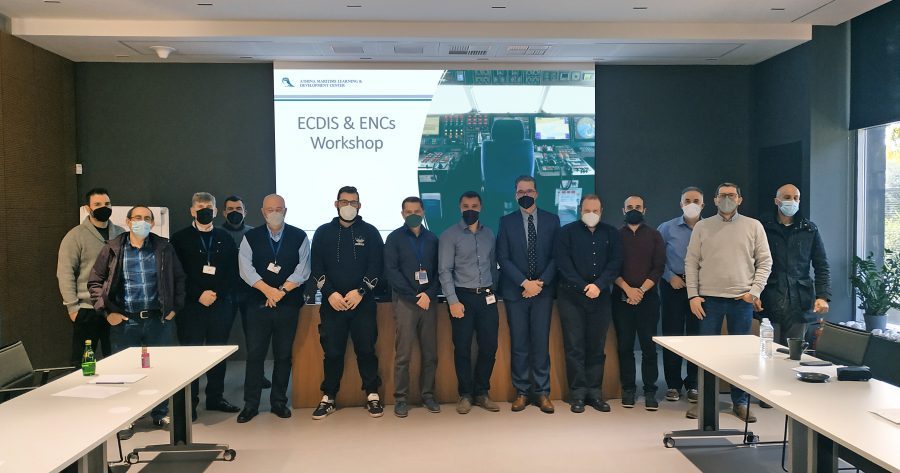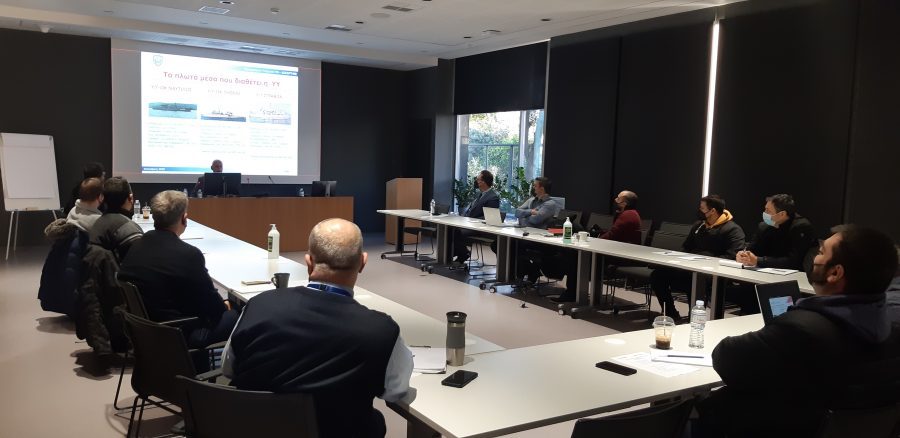A Workshop on the ECDIS and the Electronic Navigational Charts was organized by the ATHINA Maritime Learning and Development Center and Minerva Marine on 19 January 2022.
The incentive to organize the Workshop was based on requests made by Officers who have attended seminars on the ECDIS and Passage Planning, on the changes in the navigation policy of the company relating to the use, safety parameters’ setting and the display configuration of ECDIS, as well as, on the developments around the S-100 product standard of the International Hydrographic Organization that pave the way to the e-navigation.
The Workshop was attended physically and remotely by around 20 Officers and shore personnel, as well as by a number of ships of Minerva Marine/Gas, for which, the time difference and schedule of operations allowed some of their Navigating Officers to participate.
Mr. Alexis Hadjiantoniou, Director of Nautical Charts & Nautical Publications Division of the Hellenic Navy Hydrographic Service gave a historical look of the Agency since 1921 and the activities in the production of ENCs according to the existing S 57 specifications. He focused on CATZOC position and depth accuracies, the compilation scale and the impact of zoom-in by giving examples relating to isolated dangers. He also presented the overall structure of the S-100 standard and explained how the migration and transition from the ENC S-57 to the specific S-101 has been scheduled to take place.
Capt. A. Prasinos, Head of the Marine Dept. of Minerva Marine, presented the key ECDIS procedures for safe navigation by explaining the steps of passage appraisal, route planning, validation (route check) and monitoring during the voyage. He focused on the company’s safety parameters, the handling of T & Ps and the importance of position fixing as a verification of GNSS derived positions displayed on the ECDIS.
The representatives of Wartsila Mr. Vladimir Kolyada from St. Petersburg and Mr. Christos Matsikoudis gave a presentation on the Naviplanner and NaviSailor 4000 ECDIS showing the additional capabilities that support the planning of voyage by calculating and considering the optimal routes. A real time simulation of the Bridge Mate followed demonstrating a back up and decision support tool based on licensed ENCs from the ECDIS that are capable of operating when the ECDIS primary and backup systems fail.
Mr. Ev. Linardatos, E-Navigation Manager of Space Electronics and representative of JRC, presented the JRC ECDIS network with Navbox, the JRC ECDIS hardware components, examples of the initial and full UKC calculations, the NVI weather service to Navstation and the digital chart table of Navstation that can additionally play the role of the back-up to the back-up system.
St. Vitorakis focused on the interface of ECDIS units with the other navigational instruments, the most common failures in the hardware and software, as well as, those failures caused by the improper operation of the system. Trends of such relatively limited failures that have been recorded since the first installations of ECDIS to Minerva Marine vessels were presented.
Capt. P. Paidousis outlined the content of ECDIS-related seminars delivered at ATHINA, the common weaknesses of Jr Officers and other ongoing efforts to support their better understanding on the numerous functions of the ECDIS.
The good interaction and discussion with the participating Minerva Marine/Gas Officers made obvious that 12 years after ECDIS and ENCs have become equivalent to paper charts in SOLAS and almost compulsory for the overwhelming majority of ocean-going vessels, the ECDIS is not a simple charts display unit but a central system of any integrated bridge causing a revolution to the safety of navigation, far beyond the advantages of real time position indication and almost automated charts correction.

